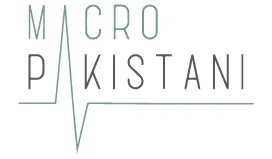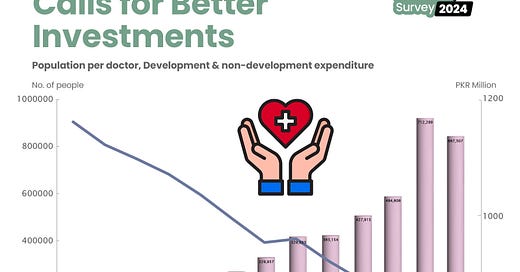Health Sector Calls for Better Investments
Pakistan only spends 1% of its GDP on the public health sector. In comparison, other South Asian countries spend at least 3.1% of their GDP.

Over the past years, Pakistan’s life expectancy has increased to 67.3 years due to various government efforts focused on the eradication of diphtheria and the reduction of child stunting. However, Pakistan is still far from achieving universal health coverage. In other words, the country needs a concerted effort to ensure that its population has access to quality health facilities. Currently, the healthcare system faces inefficiencies and quality issues due to poor accountability and unregulated private sector practices. The public sector is understaffed and has low job satisfaction. Therefore, improving medical education and addressing social determinants is essential for a broader impact. This requires improved funding and accountability practices, something that can not be achieved by Pakistan’s low spending.
Will Federal and Provincial governments raise health allocations to 3% of GDP as pledged in Pakistan Vision 2025 to gain the benefits of investing in health?
One of the core components of Pakistan’s healthcare system is its doctors and other healthcare personnel. Lady health workers in particular have emerged as a crucial tool of primary health outreach. To ensure efficient healthcare delivery, it's crucial to increase the number of healthcare professionals. In 2023, there were 299,113 registered doctors and 36,032 dentists, marking a 5.9% and 8.7% increase from 2022, respectively. The country also has 127,855 nurses, 46,110 midwives, and 24,022 lady health workers. To ensure the quality of healthcare professionals, the country needs proper accreditation. Many low and middle-income countries have created national accreditation standards to regulate and improve healthcare. India developed its system in the late 2000s. Pakistan lacks a national accreditation system, but Punjab and Sindh Health Care Commissions have established Minimal Service Delivery Standards (MSDS) for accrediting healthcare facilities.
In conclusion, Pakistan needs to increase health spending to 3% of GDP to improve healthcare access and quality. Despite progress, the system suffers from inefficiencies and poor regulation. Therefore key reforms include better medical education, more healthcare professionals, and national accreditation standards to achieve universal health coverage and better health outcomes.
GRAPHIC
In case anyone wants to contribute (to the Palestine solidarity campaign on Macro Pakistani) and send data-backed content, please feel free to send an email to fakiha.rizvi@brandnib.com
Team Brand Nib (@brandnib)
Team @brandnib visualized a lot of budget specific content from the Budget FY 24-25 documents and some key takeaways from the Pakistan Economic Survey 2024 with the help of Sharmeen Sajjad our hard-working Head of Content Research! We cannot fit all of it here, but please do visit the @macropakistani Instagram account to see all the effort we have done to make these two crucial documents related to Pakistan’s economy more digestible!
We are also thankful to all the followers and subscribers (especially the team at OICCI) who have appreciated the data-driven content that we have produced during this week.
Fun fact: The only ‘yes/no’ poll on Macro Pakistani that never got a ‘no’!
The government has imposed new tax slabs for salaried persons in FY25, doubling the tax for someone earning PKR 50,000 monthly, just slightly above the minimum wage. In addition to salary income, higher taxes have been imposed for all business income slabs, with harsh raises that may deter filers rather than improve revenues.
Despite maintaining a primary surplus of 0.4% of GDP, Pakistan’s fiscal deficit for FY25 is projected to be 7.4% of GDP, according to the IMF. The IMF has also projected $21 billion for Pakistan’s external financing needs in FY25, approximately 157% of the country's reserves.
Pakistan’s twin deficits are projected to remain problematic for the upcoming years, with the overall deficit in the first eight months of the current fiscal year estimated at 3% of GDP. To address this, revenue-driven fiscal consolidation is needed.
Data Visualization & Marketing Partner: Brand Nib
Visit: https://macropakistani.com/advertise/
Grateful for the ever-growing list of collaborators!
About Us: Macro Pakistani is a data-driven research platform that aims to provide a basic understanding of Pakistan’s economy. If you have an interest in contemporary news but are currently overburdened with sensationalism and specialized vocabulary, we are the platform for you.
How are we doing? Please send us any questions, comments or suggestions by replying to this email.








